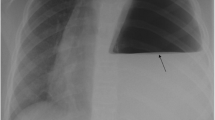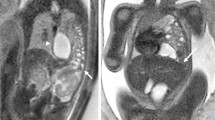Abstract
Congenital rachischisis and brachioesophagus with secondary intrathoracic stomach, which is described as “serpentine-like syndrome”, is a very rare condition. We report the prenatal findings of serpentine-like syndrome in a fetus at 18 weeks of gestation. The stomach was entirely elevated into the thoracic area, but the liver retained its normal position. Our initial diagnosis was isolated left congenital diaphragmatic hernia (CDH). At 20 weeks of gestation, the pregnancy was terminated, and a male newborn weighing 338 g was vaginally delivered. The autopsy findings revealed an extremely short esophagus, and the stomach was located in the posterior mediastinum as a result of congenital esophagus hiatal hernia. A severe case of rachischisis was identified from the cervical to thoracic vertebrae. The prognosis of congenital intrathoracic stomach associated with serpentine-like syndrome is extremely poor compared to the prognosis of isolated CDH. It is difficult to make a definite diagnosis by ultrasound alone; however, atypical findings, such as the presence of the entire intrathoracic stomach despite the normally located liver, may warrant further exploration. Obstetricians and neonatal clinicians presented with similar cases should be alerted to the significance of these prenatal findings and the differences in outcomes to ensure appropriate counseling of parents.




Similar content being viewed by others
References
Katz MS, Hess DJ, Caty MG, et al. Of snakes and babies: intrathoracic stomach and vertebral rachischisis. A serpentine-like syndrome? J Pediatr Surg. 2008;43:1385–9.
Deprez FC, Debauche C, Clapuyt P, et al. Multiorgan developmental anomalies presenting as a variation of the serpentine-like syndrome: cervical fusion and brachioesophagus with intrathoracic stomach and malposition of duodenopancreas and spleen. J Pediatr Surg. 2009;44:E25–8.
Nakamura H, Okazaki T, Koga H, et al. Congenital brachioesophagus with secondary intrathoracic stomach associated with rachischisis described as “serpentine-like syndrome”: a case report and literature review. Pediatr Surg Int. 2012;28:63–6.
Lall A, Morabito A, Bianchi A. “Total Gastric Dissociation (TGD)” in difficult clinical situations. Eur J Pediatr Surg. 2006;16:396–8.
Leung AW, Lam HS, Chu WC, et al. Congenital intrathoracic stomach: short esophagus or hiatal hernia? Neonatology. 2008;93:178–81.
Dorum BA, Korkmaz S, Özkan H, et al. Serpentine-like syndrome associated with encephalocele. Clin Dysmorphol. 2016;25:110–2.
Beleza-Meireles A, Steenhaut P, Hocq C, et al. “Serpentine-like syndrome”—a very rare multiple malformation syndrome characterised by brachioesophagus and vertebral anomalies. Eur J Med Genet. 2017;60:100–4.
Pierre R, Eduardo DR, David AP. Pathology of pediatric gastrointestinal and liver disease. New York: Springer; 2004. p. 3–18.
Kilian AK, Büsing KA, Schuetz EM, et al. Fetal MR lung volumetry in congenital diaphragmatic hernia (CDH): prediction of clinical outcome and the need for extracorporeal membrane oxygenation (ECMO). Klin Padiatr. 2009;221:295–301.
Deprest JA, Flemmer AW, Gratacos E, et al. Antenatal prediction of lung volume and in utero treatment by fetal endoscopic tracheal occlusion in severe isolated congenital diaphragmatic hernia. Semin Fetal Neonatal Med. 2009;14:8–13.
Usui N, Okuyama H, Kanamori Y, et al. The lung to thorax transverse area ratio has a linear correlation with the observed to expected lung area to head circumference ratio in fetuses with congenital diaphragmatic hernias. J Pediatr Surg. 2014;49:1191–6.
Kitano Y, Okuyama H, Saito M, et al. Re-evaluation of stomach position as a simple prognostic factor in fetal left congenital diaphragmatic hernia: a multicenter survey in Japan. Ultrasound Obstet Gynecol. 2011;37:277–82.
Di Francesco S, Lanna MM, Napolitano M, et al. A case of ultrasound diagnosis of fetal hiatal hernia in late third trimester of pregnancy. Case Rep Obstet Gynecol. 2015;2015:194090.
Acknowledgements
This study was supported by Grants-in-Aid for Scientific Research (17K11233, 15K10669, 26670724) from the Ministry of Education, Culture, Sports, Science and Technology of Japan, and from the Japan Society for the Promotion of Science. The authors would like to thank Enago (http://www.enago.jp) for the English language review.
Author information
Authors and Affiliations
Corresponding author
Ethics declarations
Ethical statements
This article does not contain any studies with human or animal subjects performed by any of the authors. Written informed consent was obtained from the patient.
Conflict of interest
The authors declare that there are no conflicts of interest regarding the publication of this paper.
About this article
Cite this article
Mimura, K., Endo, M., Matsuoka, K. et al. Prenatal findings of serpentine-like syndrome with congenital intrathoracic stomach: differential diagnosis from congenital diaphragmatic hernia. J Med Ultrasonics 46, 263–266 (2019). https://doi.org/10.1007/s10396-018-0896-8
Received:
Accepted:
Published:
Issue Date:
DOI: https://doi.org/10.1007/s10396-018-0896-8




